Watershed Stewardship

Stream Bank Erosion
As cities and neighborhoods become more developed, more impervious surfaces (concrete, asphalt, rooftops) are covering what once was vegetated ground. Impervious surfaces and compacted soils prevent stormwater infiltration and contribute pollutants from andscapes like oil, grease, metals, and fertilizers. These pollutants often run into storm drains, which in turn, run directly into local rivers and streams. The result? Too much water flowing into urban streams in a short amount of time, carrying pollutants and high water flows that can erode urban streambanks.
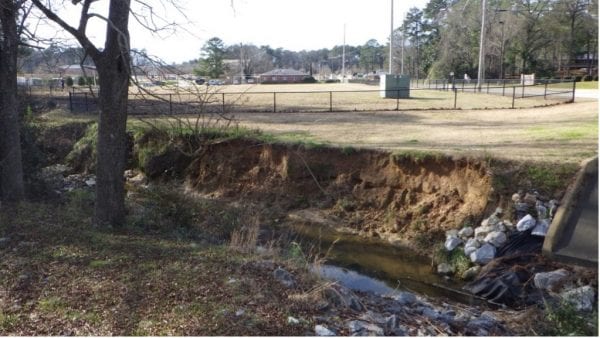
Flash flows can cause severe erosion in urban streams
Restoring a stream’s riparian buffers, the 6 to 10 feet of vegetation on a stream bank, can play a large role in reducing stream bank erosion. Riparian buffers are permanent vegetation zones along a stream that help control non-point source pollution and improve water quality. Restoring vegetation around stream banks is critical in providing wildlife habitat, stabilizing the soil, and filtering out increased nutrients and pollution.
Without plants and roots holding on to it, soil is more likely to be washed away into waterways during heavy rain events. Live staking is an inexpensive practice that can help restore native vegetation in a riparian buffer.
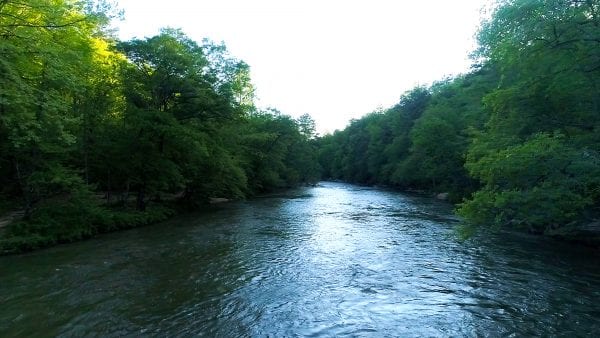
Healthy Riparian Buffer
What is Live Staking?
Live stakes are stem cuttings taken from smaller trees during their dormant season (before their buds open). In Alabama and other Southeastern states, it is best to do live staking from late September to early March when plants are still dormant. The live stakes are then inserted directly into the stream bank. These plantings will eventually grow into new trees and is a successful way to establish root networks that help prevent further soil erosion.
Harvesting Live Stakes
Live stakes can be bought from local nurseries, or harvested for free from native vegetation growing in the region. Common species used in live staking include native plants that excel along riparian buffers, including silky dogwood, willows, elderberry, and similar species. Be sure to plant species that are native to the area.
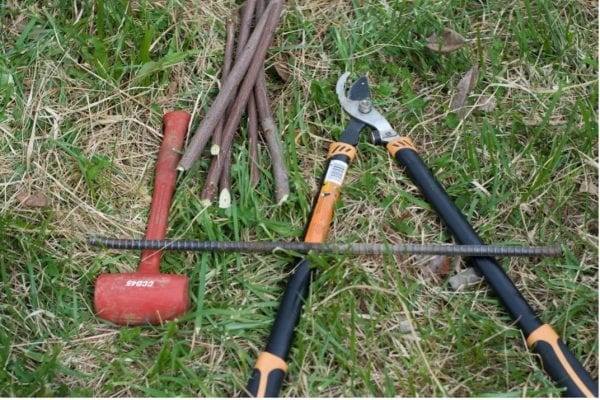
Tools for Live Staking
Tools Needed
- Loppers
- Rubber Mallet
- Rebar
- Waders (or tall waterproof boots)
- Gloves (optional)
Live Staking Method
Step 1. Cut the live stakes.
Identify a location with the native plants species you wish to plant. Get permission from the landowner if needed. To begin, find branches on the trees that are about ½ to 1½ inches in diameter. Use loppers to cut a branch at the base of the plant. You should cut the branch into in two to three feet sections. Cut the bottom of the stake at an angle to form a point or a “stake.” This point will help you insert them into the ground.
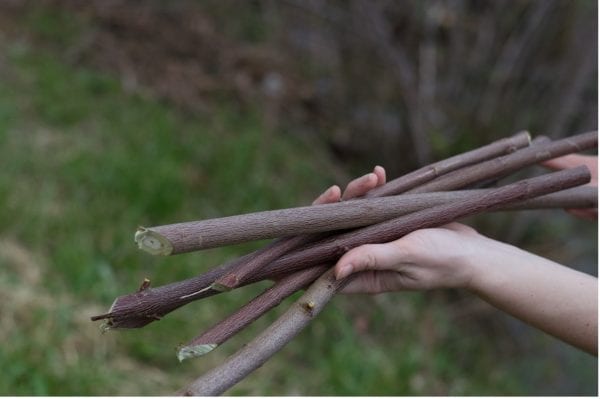
Live Stakes Cut for Use
Some branches might be suitable for cutting into multipe live stakes, but trim off any smaller side branches from the stakes. If you are collecting a large number of stakes and it will be a while before they are planted, place the live stakes in a bucket of water to keep them from drying out. When you plant these, make a new, angled cut on the live stakes. Installing live stakes soon after harvest is preferred to encourage successful establishment.
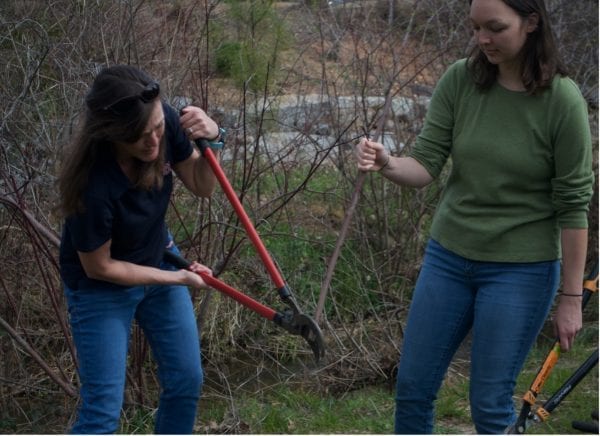
Live Stake Cut at an Angle
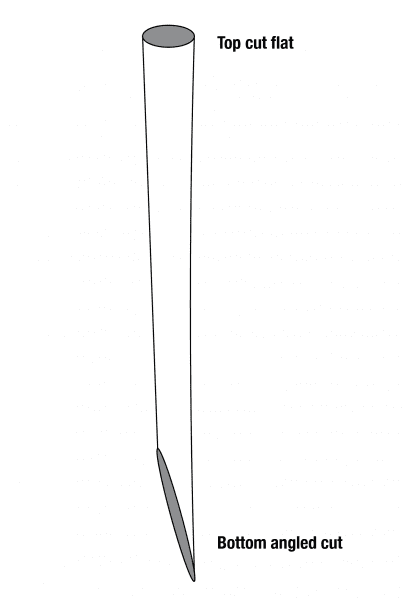
How to Cut a Live Stake
Step 2: Planting the Live Stakes
Since planting live stakes will most likely require you to get into the stream, waders or high waterproof boots are recommended. To make the planting process more manageable, use a one-to-two-foot piece of rebar (or something similar) to create pilot holes evenly two to three feet apart along the stream bank. A mallet hammer can also be used to pound the rebar into the ground to make the hole.
Planting the live stakes in a triangular pattern to increase density is a common practice because there is an assumption that not all of the live stakes will survive. Be sure that live stakes are planted close enough to the stream that they are within the water table. Live stakes need moisture in their soil to survive.
After creating a pilot hole at a 90-degree angle into the soil surface, insert the live stake’s angled end into the pilot hole at the same 90-degree angle until about half of the stake is in the ground. If live stakes are correctly planted, you can expect upwards of 80 percent stake survival.
Planting Tips
- Plan the design before the planting date or estimate as you go along.
- Make all of the pilot holes before you start planting the live stakes, or make the pilot holes and plant the live stakes simultaneously.
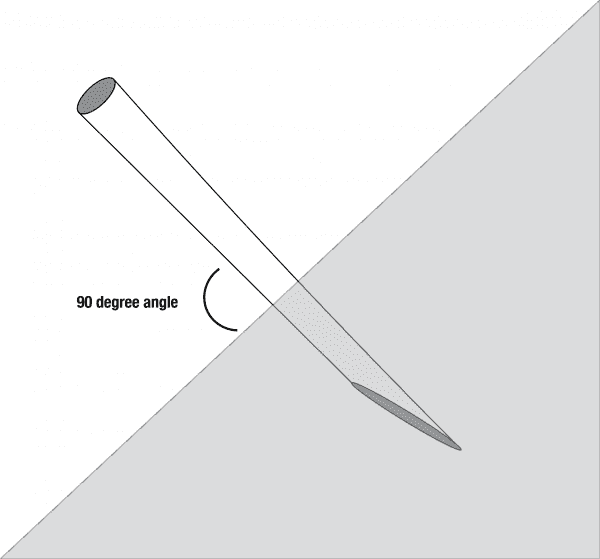
Insert Live Stake at a 90 Degree Angle
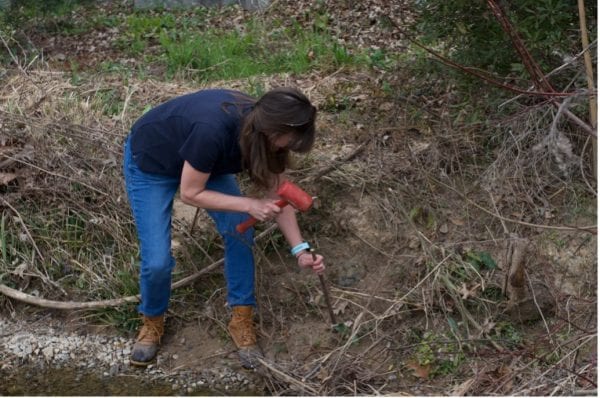
Installing a Native Plant Live Stake into Stream Bank
Step 3: Planting After Care
During the first year of growth, live stakes will focus most of their energy and nutrients towards root development. Sometimes, you will see some leaf growth in the first growing season. Do not be discouraged if you do not see leaf growth. To determine how successful your planting was, you can give the live stakes a gentle tug to test the root development after the first growing season. If all of the plantings did not survie, you can always plant more.
Native plant live stakes can be an inexpensive way to restore your local urban waterways.

